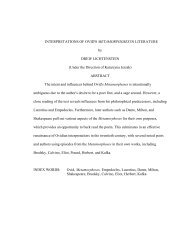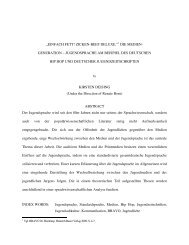RED BOAT TROUPES AND CANTONESE ... - University of Georgia
RED BOAT TROUPES AND CANTONESE ... - University of Georgia
RED BOAT TROUPES AND CANTONESE ... - University of Georgia
You also want an ePaper? Increase the reach of your titles
YUMPU automatically turns print PDFs into web optimized ePapers that Google loves.
o’clock a.m. After the main feature, the tin kwong hei (dawn play) was staged. It was an<br />
acrobatic wu play (kungfu performance mainly by apprentices) that lasted until daybreak.<br />
A hundred years ago when transportation and infrastructure on land was limited,<br />
performing troupes in the estuary relied heavily on flat bottom boats for traveling on the shallow<br />
and narrow river. According to Wong Toa, depending on how fast a troupe needed to be at a<br />
performing site, most times the boats use rows for traveling in the inner river. At times when the<br />
wind blew in the right direction, canvas was used, and if the troupe needed to rush to another<br />
location, a motorboat was hired to tug the two red boats. 83 Where the river was narrow, in<br />
addition to rowing, men on the shore tugged the boats. Two sailors guarded the travel day and<br />
night. 84 These guards were also assigned interesting jobs—notifying instrumentalist to play<br />
birthday music, paying toll, and burning worshiping paper as the boats approached temples <strong>of</strong> the<br />
Goddess <strong>of</strong> the Sea. Punctuality for the subsequent performances was the guards’ responsibility.<br />
The high demand <strong>of</strong> opera performance at a time <strong>of</strong> relative political stability in the<br />
1920s and 1930s turned the simple Red Boat operation into enterprises. Enterprises built<br />
permanent theaters in the cities <strong>of</strong> Guangzhou and Hong Kong. Troupes frequently travelled<br />
between cities. Since Red Boat Troupe became saan gong daai baan (large troupes plays in<br />
Quangzhou and Hong Kong), and with steamers available for travelling between Guangzhou and<br />
Hong Kong, more performers took the passenger ferry in the morning to Hong Kong from<br />
Guangzhou and were able to perform in the evening show. The second and third floor <strong>of</strong> most<br />
theatres in Hong Kong had beds to accommodate travelling performers. 85 Po Hing and Gou Sing<br />
line was run by the Sit Gok Sin group, while the Tai Ping and Dong Lok line was run by the Ma<br />
Si Tsung group. The two rival groups performed continuously for almost ten years, before the<br />
83 Interview with Wong Toa<br />
84 The model at the Foshan Museum has a canon at the bow to protect the troupes from pirates<br />
85 Interview with Wong Toa in Vancouver, Canada.<br />
34






